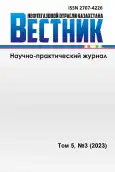Study of the efficiency of machine learning algorithms based on data of various rocks
- 作者: Assilbekov B.K.1,2, Kalzhanov N.Y.2,3, Bolysbek D.A.1,3, Uzbekaliyev K.S.1, Bekbau B.Y.1, Kuljabekov A.B.1,2
-
隶属关系:
- Satbayev University
- KBTU BIGSoft
- Al-Farabi Kazakh National University
- 期: 卷 5, 编号 3 (2023)
- 页面: 5-19
- 栏目: Геология и геофизика
- URL: https://bakhtiniada.ru/2707-4226/article/view/249738
- DOI: https://doi.org/10.54859/kjogi108649
- ID: 249738
如何引用文章
全文:
详细
Background: Absolute permeability plays an important role in studying the fluids flow in porous media during the development of oil and gas reservoirs, the injection of CO2 into reservoirs for storage, the monitoring of pollutants migration in underground aquifers, and the modeling of catalytic systems. Therefore, an accurate and fast evaluation of its values is an important task.
Aim: The purpose of this article is to study the applicability of machine learning methods for predicting the absolute permeability of carbonate samples, as well as ways to improve the prediction of permeability.
Materials and methods: The input data is 408 small volumes extracted from four cylindrical carbonate samples composed almost entirely of calcite. Input data includes total and connected porosity, specific surface area, radii of all and only connected pores, coordination number, throat radius and length, tortuosity, and absolute permeability. Permeability prediction is carried out using regression machine learning methods such as random forest, extremely random trees and extended gradient boosting. Parameters (data) of small volumes were determined using pore-scale modeling of water flow in their pore space applying a specialized Avizo software.
Results: Data of small volumes extracted from fractured and non-fractured samples were analyzed, and the results showed that there are good relationships between many parameters of small volumes. For example, the connected and total porosity have a second-order polynomial relationship with a high correlation coefficient. Using the above-mentioned regression machine learning methods, absolute permeability values were predicted when input data divided into training and testing data in a ratio of 80/20 and 70/30.
Conclusion: Using the logarithm of permeability instead of permeability itself and considering fractured and non-fractured samples separately, can increase the accuracy of absolute permeability prediction using the above-mentioned machine learning methods up to 90%. The extremely random trees method is the most accurate among the three machine learning methods considered for our task.
作者简介
Bakhytzhan Assilbekov
Satbayev University; KBTU BIGSoft
Email: assibekov.b@gmail.com
ORCID iD: 0000-0002-0368-0131
PhD
哈萨克斯坦, Almaty; AlmatyNurlykhan Kalzhanov
KBTU BIGSoft; Al-Farabi Kazakh National University
Email: nurkal022@gmail.com
ORCID iD: 0009-0008-5776-0971
哈萨克斯坦, Almaty; Almaty
Darezhat Bolysbek
Satbayev University; Al-Farabi Kazakh National University
编辑信件的主要联系方式.
Email: bolysbek.darezhat@gmail.com
ORCID iD: 0000-0001-8936-3921
哈萨克斯坦, Almaty; Almaty
Kenboy Uzbekaliyev
Satbayev University
Email: kzkenbai@gmail.com
ORCID iD: 0009-0000-6917-4963
哈萨克斯坦, Almaty
Bakbergen Bekbau
Satbayev University
Email: bakbergen@gmail.com
ORCID iD: 0000-0003-2410-1626
PhD
AlmatyAlibek Kuljabekov
Satbayev University; KBTU BIGSoft
Email: alibek.kuljabekov@gmail.com
ORCID iD: 0000-0003-4384-6463
PhD
哈萨克斯坦, Almaty; Almaty参考
- Carman PC. Fluid flow through granular beds. Chem Eng Res Des. 1997;75:S32–S48. doi: 10.1016/S0263-8762(97)80003-2.
- Eichheimer P, Thielmann M, Fujita W, et al. Combined numerical and experimental study of microstructure and permeability in porous granular media. Solid Earth. 2020;11(3):1079–1095. doi: 10.5194/se-11-1079-2020.
- Mostaghimi P, Blunt MJ, Bijeljic B. Computations of Absolute Permeability on Micro-CT Images. Math Geosci. 2013;45(1):103–125. doi: 10.1007/s11004-012-9431-4.
- Luquot L, Rodriguez O, Gouze P. Experimental Characterization of Porosity Structure and Transport Property Changes in Limestone Undergoing Different Dissolution Regimes. Transp Porous Media. 2014;101(3):507–532. doi: 10.1007/s11242-013-0257-4.
- Noiriel C, Gouze P, Bernard D. Investigation of porosity and permeability effects from microstructure changes during limestone dissolution. Geophys Res Lett. 2004;31(24):1–4. doi: 10.1029/2004GL021572.
- Smith MM, Sholokhova Y, Hao Y, Carroll SA. CO2-induced dissolution of low permeability carbonates. Part I: Characterization and experiments. Adv Water Resour. 2013;62:370–387. doi: 10.1016/j.advwatres.2013.09.008.
- Koponen A, Kataja M, Timonen J. Permeability and effective porosity of porous media. Phys Rev E. 1997;56(3):3319–3325. doi: 10.1103/PhysRevE.56.3319.
- Mavko G, Nur A. The effect of a percolation threshold in the Kozeny-Carman relation. GEOPHYSICS. 1997;62(5):1480–1482. doi: 10.1190/1.1444251.
- Bernabe Y, Brace WF, Evans B. Permeability, porosity and pore geometry of hot-pressed calcite. Mech Mater. 1982;1(3):173–183. doi: 10.1016/0167-6636(82)90010-2.
- Nishiyama N, Yokoyama T. Permeability of porous media: Role of the critical pore size. J Geophys Res Solid Earth. 2017;122(9):6955–6971. doi: 10.1002/2016JB013793.
- Elmorsy M, El-Dakhakhni W, Zhao B. Generalizable Permeability Prediction of Digital Porous Media via a Novel Multi-Scale 3D Convolutional Neural Network. Water Resour Res. 2022;58(3). doi: 10.1029/2021WR031454.
- Tian J, Qi C, Sun Y, Yaseen ZM, Pham BT. Permeability prediction of porous media using a combination of computational fluid dynamics and hybrid machine learning methods. Eng Comput. 2021;37(4):3455–3471. doi: 10.1007/s00366-020-01012-z.
- Mohammadian E, Kheirollahi M, Liu B, Ostadhassan M, Sabet M. A case study of petrophysical rock typing and permeability prediction using machine learning in a heterogenous carbonate reservoir in Iran. Sci Rep. 2022;12(1):4505. doi: 10.1038/s41598-022-08575-5.
- Rezaee R, Ekundayo J. Permeability Prediction Using Machine Learning Methods for the CO2 Injectivity of the Precipice Sandstone in Surat Basin, Australia. Energies. 2022;15(6):2053. doi: 10.3390/en15062053.
- Gholami R, Shahraki AR, Jamali Paghaleh M. Prediction of Hydrocarbon Reservoirs Permeability Using Support Vector Machine. Math Probl Eng. 2012;2012:1–18. doi: 10.1155/2012/670723.
- Erofeev A, Orlov D, Ryzhov A, Koroteev D. Prediction of Porosity and Permeability Alteration Based on Machine Learning Algorithms. Transp Porous Media. 2019;128(2):677–700. doi: 10.1007/s11242-019-01265-3.
- Tembely M, AlSumaiti AM, Alameri W. A deep learning perspective on predicting permeability in porous media from network modeling to direct simulation. Comput Geosci. 2020;24(4):1541–1556. doi: 10.1007/s10596-020-09963-4.
- Akasheva Z, Bolysbek D, Assilbekov B. Study of carbonate rock dissolution using x-ray microcomputed tomography: impact of acid flow rate. News Natl Acad Sci Repub Kazakhstan Ser Geol Tech Sci. 2023;1(457):20–32. doi: 10.32014/2023.2518-170Х.256.
- Shahani NM, Zheng X, Liu C, Hassan FU, Li P. Developing an XGBoost Regression Model for Predicting Young’s Modulus of Intact Sedimentary Rocks for the Stability of Surface and Subsurface Structures. Front Earth Sci. 2021;9. doi: 10.3389/feart.2021.761990.
- Hameed MM, AlOmar MK, Khaleel F, Al-Ansari N. An Extra Tree Regression Model for Discharge Coefficient Prediction: Novel, Practical Applications in the Hydraulic Sector and Future Research Directions. Armaghani D, ed. Math Probl Eng. 2021;2021:1–19. doi: 10.1155/2021/7001710.
补充文件




















